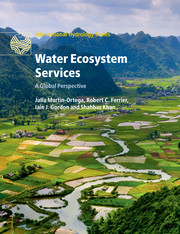Book contents
- Frontmatter
- Contents
- List of contributors
- Preface
- 1 Introduction
- 2 What defines ecosystem services-based approaches?
- Part I Addressing global challenges
- Part II Applying frameworks for water management and biodiversity conservation under an ecosystem services-based approach
- Part III Assessing water ecosystem services
- 9 The first United Kingdom's National Ecosystem Assessment and beyond
- 10 Using an ecosystem services-based approach to measure the benefits of reducing diversions of freshwater: a case study in the Murray-Darling basin, Australia
- 11 An ecosystem services-based approach to integrated regional catchment management: the South East Queensland experience
- 12 Policy support systems for the development of benefit-sharing mechanisms for water-related ecosystem services
- 13 Assessing biophysical and economic dimensions of societal value: an example for water ecosystem services in Madagascar
- 14 Rapid land use change impacts on coastal ecosystem services: a South Korean case study
- Part IV Broadening the perspective
- Index
- Plate Section
- References
12 - Policy support systems for the development of benefit-sharing mechanisms for water-related ecosystem services
from Part III - Assessing water ecosystem services
Published online by Cambridge University Press: 05 May 2015
- Frontmatter
- Contents
- List of contributors
- Preface
- 1 Introduction
- 2 What defines ecosystem services-based approaches?
- Part I Addressing global challenges
- Part II Applying frameworks for water management and biodiversity conservation under an ecosystem services-based approach
- Part III Assessing water ecosystem services
- 9 The first United Kingdom's National Ecosystem Assessment and beyond
- 10 Using an ecosystem services-based approach to measure the benefits of reducing diversions of freshwater: a case study in the Murray-Darling basin, Australia
- 11 An ecosystem services-based approach to integrated regional catchment management: the South East Queensland experience
- 12 Policy support systems for the development of benefit-sharing mechanisms for water-related ecosystem services
- 13 Assessing biophysical and economic dimensions of societal value: an example for water ecosystem services in Madagascar
- 14 Rapid land use change impacts on coastal ecosystem services: a South Korean case study
- Part IV Broadening the perspective
- Index
- Plate Section
- References
Summary
12.1 INTRODUCTION
There are a number of persistent oversimplifications in the lay understanding of water ecosystem services; for example: forests generate more water, forests prevent floods, forests sustain dry season flows, forests improve water quality. The reality is that the role of forests in water ecosystem services depends on (1) the landscape and climate context (terrain, rainfall, seasonality, storm characteristics, drought characteristics), (2) the type of forest, (3) the land cover and land use alternatives to forest cover and its management; and (4) the distribution of people locally and downstream of the site in question and their demand for ecosystem services. Another key control is the area of the forest in relation to other land uses and its location in relation to spatial heterogeneity of climate and other environmental properties and relative to downstream populations. Water ecosystem services are hence fundamentally a property of climate, but land cover and land use can have an impact on: water balance (through land cover effects on evapotranspiration and fog inputs); on runoff partitioning (through land cover and management effects on infiltration and runoff rates, on slope gradients and on subsurface flows); and through secondary impacts on water through agricultural water use and management infrastructure. Water balance in turn impacts on the services of water provision through control of infiltration (soil water used in transpiration) and river runoff. Seasonality is also a strong control on water regulation and on water quality. The impact of human-induced land cover and land use on water ecosystem services will depend on the magnitude of human intervention in relation to other cover types at the catchment scale and the location of human land cover and land use in relation to topographic, climatic, and soil factors in the catchment and in relation to beneficiaries downstream. The impact of a single farmer's actions on downstream water ecosystem services may be small, but the action of many farmers can produce non-linear cumulative downstream responses.
- Type
- Chapter
- Information
- Water Ecosystem ServicesA Global Perspective, pp. 99 - 109Publisher: Cambridge University PressPrint publication year: 2015
References
- 1
- Cited by



